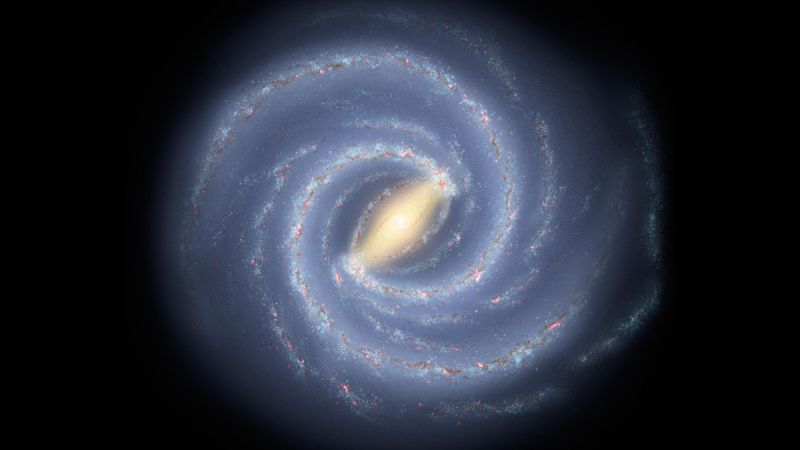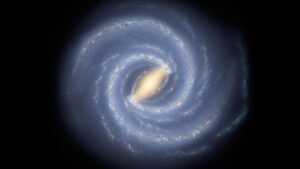
Astronomers have long predicted a collision between the Milky Way and its nearest large neighbor, the Andromeda galaxy, in approximately 4.5 billion years. However, recent research suggests that this galactic clash, often referred to as “Milkomeda,” may be less likely than previously thought. This revelation stems from a study published in the journal Nature Astronomy, which indicates a significantly reduced probability of such an event occurring within the expected timeframe.
The galaxies, separated by about 2.5 million light-years, are moving toward each other at a staggering speed of approximately 223,694 miles per hour (100 kilometers per second). Despite this apparent collision course, the study reveals that the odds of a merger happening in the next 4 to 5 billion years are only about 2%, a stark contrast to earlier predictions.
Reevaluating Galactic Dynamics
The research team, led by astronomers using data from the Hubble and Gaia space telescopes, considered the gravitational influences of other galaxies within the Local Group, a collection of about 100 galaxies including the Milky Way and Andromeda. Among these, the Large Magellanic Cloud (LMC) and the Triangulum galaxy (M33) play significant roles in the dynamics of the group.
By running 100,000 simulations that incorporated these factors, the team found a 50% chance of a collision within the next 10 billion years. This is a considerable extension of the timeline compared to previous estimates. The gravitational pull of the LMC and M33 appears to alter the trajectory of the Milky Way enough to reduce the likelihood of an imminent collision with Andromeda.
Implications of a Galactic Merger
Should a merger occur, it would transform both spiral galaxies into a single elongated structure, potentially resulting in “cosmic fireworks” as gas feeds a central black hole, emitting significant radiation. “Until now we thought this was the fate that awaited our Milky Way galaxy,” said study coauthor Carlos Frenk, a professor at Durham University in England. “We now know that there is a very good chance that we may avoid that scary destiny.”
However, uncertainties remain. Frenk notes that the Milky Way might collide with the LMC within 2 billion years, a scenario that could fundamentally alter our galaxy’s structure.
Simulating Galactic Collisions
The LMC, although only about 15% of the Milky Way’s mass, exerts a gravitational pull that affects the Milky Way’s motion, making a merger with Andromeda less likely. Similarly, the M33 influences the dynamics by pulling the Milky Way slightly more towards it.
Lead study author Dr. Till Sawala from the University of Helsinki explained, “The LMC pulls the Milky Way off the orbital plane and away from Andromeda. It doesn’t mean that the LMC will save us from that merger, but it makes it a bit less likely.”
“We ran many thousands of simulations, which allowed us to account for all the observational uncertainties,” Sawala said. “Because there are so many variables that each have their errors, that accumulates to rather large uncertainty about the outcome, leading to the conclusion that the chance of a direct collision is only 50% within the next 10 billion years.”
Future Observations and Predictions
Future data from the Gaia space telescope, expected in 2026, will help refine measurements of Andromeda’s speed and direction, potentially altering predictions further. Scott Lucchini, a postdoctoral fellow at the Center for Astrophysics, Harvard & Smithsonian, emphasized the importance of accounting for uncertainties in galactic positions, velocities, and masses.
Geraint Lewis, a professor of astrophysics at the University of Sydney, remarked on the study’s findings, noting that while a collision is not definitively off the table, the narrative of an inevitable galactic destruction is not as certain as once believed.
The Fate of Earth and the Sun
While the potential collision between the Milky Way and Andromeda garners much attention, the fate of Earth may be more directly impacted by the sun’s lifecycle. As our sun ages, it will eventually become a red giant, potentially engulfing Earth in about 5 billion years.
“The short answer is that the end of the sun is far worse for our planet than the collision with Andromeda,” Sawala said. “While that merger would mean the end of our galaxy, it would not necessarily be the end of the sun or the Earth.”
In conclusion, while the study provides a more nuanced understanding of the future interactions between the Milky Way and Andromeda, it also highlights the complexities and uncertainties inherent in predicting cosmic events. As new data becomes available, our understanding of these galactic dynamics will continue to evolve, offering deeper insights into the universe’s grand design.




